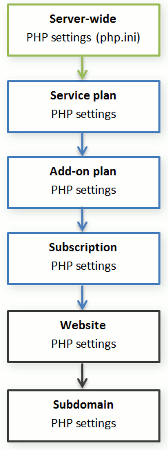PHP is one of the most popular scripting languages for creating dynamic
web pages. The majority of today’s websites and web applications are
based on PHP scripts. Thus, site administrators should understand how
they can control the execution of PHP scripts. Typically, PHP behavior
is defined by a number of configuration settings. These settings specify
various script execution aspects, like performance (for example, the
amount of memory a script can use), security (for example, access to
file system and services), and so on. Administrators might want to
adjust these settings for a number of reasons:
- Preventing a memory leak or server hang-up by poorly written scripts.
- Protecting data from malicious scripts.
- Meeting the requirements of a certain web app.
- Testing own scripts and other.
Custom PHP Settings in Plesk
Generally, PHP settings are defined by the server-wide configuration
file. For Linux it is, typically, /etc/php.ini and for Windows -
%WIN%php.ini. This file is managed by your hosting provider and
defines PHP configuration for all websites hosted on the server. Since
Plesk 10.4, PHP settings are adjustable through the Customer Panel and
you can adjust them individually for each hosting plan or subscription.
Moreover, your customers (if allowed) can adjust your PHP settings
preset individually for each of their websites and subdomains. See the
PHP settings hierarchy on the diagram below.

certain service plan, add-on plan, or subscription (on the PHP
Settings tab). PHP settings from a higher level act as a preset
for a lower level, thus each lower level overrides them. For example,
you can consciously apply some PHP limitations to a service plan and
then offer your customers the add-on plan that removes the
limitations. PHP settings of the add-on plan will override the
settings defined in the main service plan.
PHP configuration that is unique for each website (or subdomain) in
their subscription.
Groups of PHP Settings
For convenience, all PHP settings in Plesk are divided into two groups:
-
Performance settings.
These settings define…